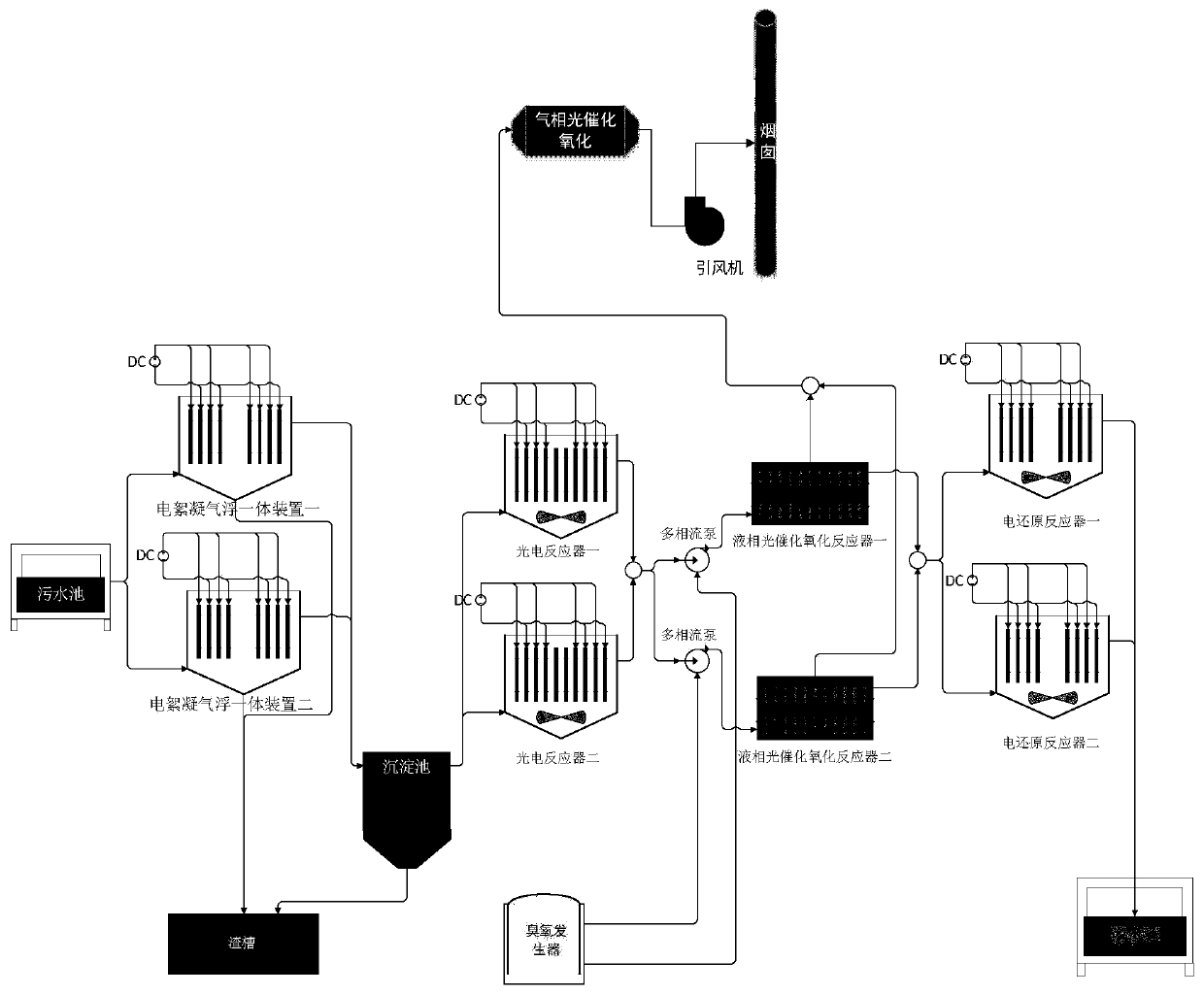Technology for treating landfill leachate by non-biochemical process
A landfill leachate, non-biochemical technology, applied in the directions of oxidized water/sewage treatment, water/sewage treatment, chemical instruments and methods, etc., can solve the problems of large investment, poor control ability, and difficulty in reaching the standard, so as to improve the reaction efficiency , The effect of improving the oxidation function and shortening the reaction time
- Summary
- Abstract
- Description
- Claims
- Application Information
AI Technical Summary
Problems solved by technology
Method used
Image
Examples
Embodiment 1
[0118] Such as figure 1 A kind of non-biochemical method treatment landfill landfill leachate technique shown, described technique comprises the steps:
[0119] Step S1: leachate electrocoagulation air flotation sedimentation treatment;
[0120] Step S2: the leachate treated in step S1 is treated by photolysis and electrochemical reaction;
[0121] Step S3: The leachate treated in step S2 is treated by an electric field cooperative photocatalytic oxidation reaction. After the test reaches the standard, the non-biochemical treatment of the leachate is completed. If the test does not meet the standard, enter step S4: the leachate treated in step S3 After the electrochemical reduction reaction treatment, the non-biochemical treatment of the leachate is completed.
[0122] Specifically, step S2 is based on a photolysis cooperative electrochemical treatment device, the device includes a device body, which is provided with a plurality of anodes, a plurality of cathodes and a refer...
Embodiment 2
[0144] A non-biochemical process for treating landfill landfill leachate is characterized in that the process comprises the following steps:
[0145] Step S1: leachate electrocoagulation air flotation sedimentation treatment;
[0146] Step S2: the leachate treated in step S1 is treated by photolysis and electrochemical reaction;
[0147] Step S3: The leachate treated in step S2 is treated by an electric field cooperative photocatalytic oxidation reaction. After the detection reaches the standard, the non-biochemical treatment of the leachate is completed. If the detection does not meet the standard, enter step S4: the leachate treated in step S3 After the electrochemical reduction reaction treatment, the non-biochemical treatment of the leachate is completed.
[0148] Specifically, step S2 is based on a photolysis cooperative electrochemical treatment device, the device includes a device body, which is provided with a plurality of anodes, a plurality of cathodes and a referen...
Embodiment 3
[0170] A non-biochemical process for treating landfill landfill leachate is characterized in that the process comprises the following steps:
[0171] Step S1: leachate electrocoagulation air flotation sedimentation treatment;
[0172] Step S2: the leachate treated in step S1 is treated by photolysis and electrochemical reaction;
[0173] Step S3: The leachate treated in step S2 is treated by an electric field cooperative photocatalytic oxidation reaction. After the test reaches the standard, the non-biochemical treatment of the leachate is completed. If the test does not meet the standard, enter step S4: the leachate treated in step S3 After the electrochemical reduction reaction treatment, the non-biochemical treatment of the leachate is completed.
[0174] Specifically, step S2 is based on a photolysis cooperative electrochemical treatment device, the device includes a device body, which is provided with a plurality of anodes, a plurality of cathodes and a reference electro...
PUM
| Property | Measurement | Unit |
|---|---|---|
| particle diameter | aaaaa | aaaaa |
Abstract
Description
Claims
Application Information
 Login to View More
Login to View More - R&D
- Intellectual Property
- Life Sciences
- Materials
- Tech Scout
- Unparalleled Data Quality
- Higher Quality Content
- 60% Fewer Hallucinations
Browse by: Latest US Patents, China's latest patents, Technical Efficacy Thesaurus, Application Domain, Technology Topic, Popular Technical Reports.
© 2025 PatSnap. All rights reserved.Legal|Privacy policy|Modern Slavery Act Transparency Statement|Sitemap|About US| Contact US: help@patsnap.com

